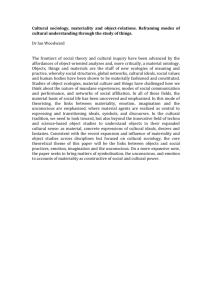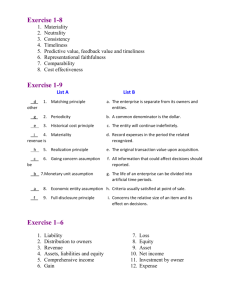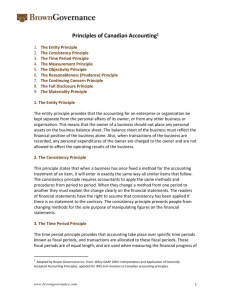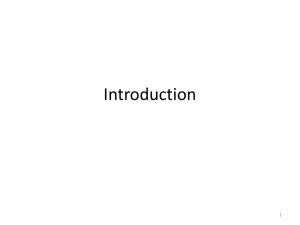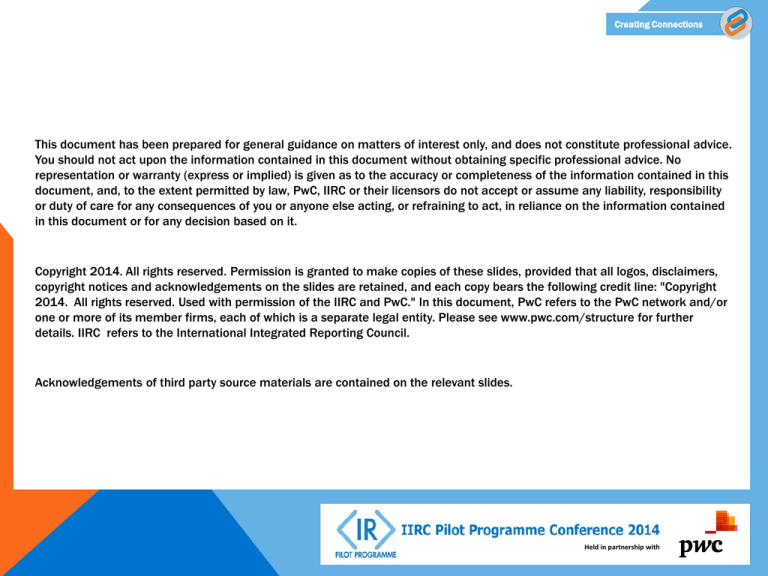
Creating Connections
This document has been prepared for general guidance on matters of interest only, and does not constitute professional advice.
You should not act upon the information contained in this document without obtaining specific professional advice. No
representation or warranty (express or implied) is given as to the accuracy or completeness of the information contained in this
document, and, to the extent permitted by law, PwC, IIRC or their licensors do not accept or assume any liability, responsibility
or duty of care for any consequences of you or anyone else acting, or refraining to act, in reliance on the information contained
in this document or for any decision based on it.
Copyright 2014. All rights reserved. Permission is granted to make copies of these slides, provided that all logos, disclaimers,
copyright notices and acknowledgements on the slides are retained, and each copy bears the following credit line: "Copyright
2014. All rights reserved. Used with permission of the IIRC and PwC." In this document, PwC refers to the PwC network and/or
one or more of its member firms, each of which is a separate legal entity. Please see www.pwc.com/structure for further
details. IIRC refers to the International Integrated Reporting Council.
Acknowledgements of third party source materials are contained on the relevant slides.
HeldHeld
in partnership
in partnership
withwith
Creating Connections
Creating Connections
Approaches to materiality
Robert van der Laan – Sustainability & Responsible
Governance Partner, PwC
Anouk Wentink – Sustainability & Responsible
Governance Manager, PwC
Stathis Gould – Head of Professional Accountants in
Business, IFAC
Denise G. Nogueira – Sustainability Manager, Itaú
Unibanco
HeldHeld
in partnership
in partnership
withwith
Creating Connections
Overview
Introduction
Methodologies
Real life case
Determining materiality for your own organization
Recap and conclusion
HeldHeld
in partnership
in partnership
withwith
Creating Connections
Introduction
Held Held
in partnership
in partnership
with with
Creating Connections
Key objectives
•
Understand approaches to determining materiality in the context of <IR>
•
Experience how to use the materiality concept
•
•
Opportunity to share your experiences and learn from others about the benefits and to
tackle difficulties and challenges facing materiality
Be equipped with insight into the next steps to embed the analysis into decision-making
and reporting
•
Be able to demonstrate materiality in an integrated report
•
Be familiar with the IIRC technical project
HeldHeld
in partnership
in partnership
withwith
Creating Connections
Materiality in the context of Integrated Reporting <IR>
‘A matter is material if it could substantively affect the organization’s ability to create
value in the short, medium or long term’
<IR> refers to 6 capitals in its value creation model, including
Financial
Manufactured
Intellectual
Human
Social and relationship
Natural
Source: The International <IR> Framework
HeldHeld
in partnership
in partnership
withwith
Creating Connections
Poll question 1
The most important benefit of knowing your material matters:
Answer 1 – Clarifies emerging matters
Answer 2 – Clarifies relevant information
Answer 3 – Clarifies stakeholder needs
Answer 4 – Foundation for <IR>
Answer 5 – Other
HeldHeld
in partnership
in partnership
withwith
Creating Connections
Relevance
Benefits of having a clear picture of what is material to the business
Paul Polman (CEO Unilever) describes how a lack of foresight hurt Unilever:
“We missed the issue of obesity and the value of healthy and nutritional food. We
were behind, while Nestlé was riding that wave. Not being in tune with society, with
the benefit of hindsight, can cost you dearly.”
Risks
Reports include too much
irrelevant information (time
consuming and costly)
•
•
•
Internal and external
reporting is not aligned
Reports are not adhering to
(information) needs of
investors/stakeholders
Organizations face more
and very diverse reporting
requirements
Benefits
1
•It provides a clear analysis of emerging
matters on the short and long term
2
•It clarifies the real matters and relevant
management information needed for
strategy execution
3
•It ensures that different
investor/stakeholder (information)
needs are taken into account
4
•It is the foundation for integrated
reporting
HeldHeld
in partnership
in partnership
withwith
Creating Connections
Methodologies
HeldHeld
in partnership
in partnership
withwith
Creating Connections
Determining materiality for Integrated Reporting
Relevance
Identifying relevant matters based on their
ability to affect value creation
Importance
Evaluating the importance of relevant matters
in terms of their known or potential effect on
value creation
Prioritization
Prioritizing the matters based on their relative
importance
Disclosure
Determining the information to disclose about
material matters
Source: The International <IR> Framework
HeldHeld
in partnership
in partnership
withwith
Creating Connections
Materiality Analysis – Intel – An Example of Disclosure
Source: Intel Business Integrated Approach, 2013
HeldHeld
in partnership
in partnership
withwith
Creating Connections
Materiality comparison between reporting standards and
frameworks
<IR> (Global)
IFRS (Global)
GRI (Global)
SASB (US)
Audience
Providers of financial capital
with a perspective on short,
medium and long term
All existing/potential investors,
lenders and other creditors
All stakeholders
Subject
matter/report
purpose
Value creation over time
Financial performance and
position
Sustainability impact
(economic, environmental,
social, and governance)
Nature of
definition
Multistep process:
• Relevant issues effect
strategy, governance,
performance, prospects
and are discussed by board
• Disclosure of material
matters based on user
need, and guiding
principles
Information is material if omitting
it or misstating it could influence
decisions that users make based
on financial information about a
specific reporting entity.
Relevance based on the nature or
magnitude, or both, of the items
to which the information relates in
the context of an individual
entity’s financial report
Organisation driven
materiality
The report should cover
aspects that:
- Reflect the organization’s
significant ESG impacts; or
- Substantively influence
the assessments and
decisions of stakeholders
Disclosure form
Integrated report
Financial statements
Sustainability (GRI) report
Investors of those companies
that engage in public offerings
of securities registered under
the Securities Act
Sustainability impact
(environment, social capital,
human capital, business model
and innovation, leadership and
governance)
SASB identifying minimum set
of sustainability topics that have
a significant impact on most, if
not all, companies in an industry
and which—depending on the
specific operating context—are
likely to be material to a
company within that industry;
guided by materiality definition
adopted by U.S. Securities laws
and case law
For use in reports filed with the
SEC
Held
Held
inin
partnership
partnership
with
with
Creating Connections
Poll question 2
Which materiality approach are you most familiar in applying?
Answer 1 – <IR>
Answer 2 – Financial (IASB/FASB/National GAAP)
Answer 3 – Sustainability (GRI/SASB)
Answer 4 – Regulated disclsoure
Answer 5 – Other
HeldHeld
in partnership
in partnership
withwith
Creating Connections
Real life case
Held Held
in partnership
in partnership
with with
Creating Connections
Itaú Unibanco
• Most relevant issues/aspects for the organization’s performance
• Support the decision making of the management and stakeholders
• Orient the selection of indicators to be reported
• Diversity of approaches and methodologies
Methodology for 2013
1
IDENTIFICATION
Business strategy
Investors perspective
Stakeholders inputs
2
PRIORITY
3
VALIDATION
Influence on stakeholder’s
appraisal and decision
Internal validation
Significance of impact (social,
environmental and economic)
External validation
(technical consultants)
Market references
Held
Held
inin
partnership
partnership
with
with
Creating Connections
Itaú Unibanco
Sustainability
Business
Learnings and challenges
• Materiality: restriction method vs focus definition
• Stakeholders involvement: direct vs indirect
• Internal validation is critical
• Capitals reporting: balanced vs proportional
• Integration to the different reporting models
• Makes sense reflects on business decisions
Held
Held
inin
partnership
partnership
with
with
Creating Connections
Materiality for your own organization
HeldHeld
in partnership
in partnership
withwith
Creating Connections
Poll question 3
What is your biggest challenge in determining material matters:
Answer 1 – Patchwork of definitions
Answer 2 – Difficulty in identifying intangible value
Answer 3 – Disconnect between financial and other data
Answer 4 – Investor/user decision needs unclear
Answer 5 - Other
HeldHeld
in partnership
in partnership
withwith
Creating Connections
Benefits and challenges of materiality
What are the benefits and challenges of determining material matters (concept
and process)?
Benefits
Challenges
Held
Held
inin
partnership
partnership
with
with
Creating Connections
What is material?
Exercise
Rank a long list of subject matters on degree of importance to your value creation
Look back and reassess the draft of material items made during step 1 of “Your
roadmap to <IR>”
Importance to value creation (1-10)
Subject matter 1
Subject matter 2
Subject matter 3
Subject matter 4
Held
Held
inin
partnership
partnership
with
with
Creating Connections
The materiality outcomes linked to your information hierarchy
What are the information
needs of the providers of
financial capital?
The high level “snap shot”
2 minute view
20 minute view
2 hour view
Integration and analysis of key information
2 day view
Materiality filter
The succinct story
A data set, to support analysis and
modelling activity
Confidentiality filter
What level of
transparency do you
want to provide to
providers of financial
capital?
Internal information set
What kind of
information hierarchy
do you want to create
for your financial
capital providers?
HeldHeld
in partnership
in partnership
withwith
Creating Connections
Link materiality to your value creation
Exercise
Link your material matters to the strategic objectives or pillars, and performance
measures (PM) for your own organization
Strategic objective 1
Strategic objective 2
Strategic objective 3
Strategic objective 4
Material
matter 1
Material
matter 2
Material
matter 3
Material
matter 4
PM
PM
PM
PM
HeldHeld
in partnership
in partnership
withwith
Creating Connections
IIRC technical project
Address confusion and provide clarity
Understanding purpose, subject matter, and how information might lead to
particular decisions by users appears to be critical in materiality process
Focus on practical application of IR materiality definition
Identify examples including of disclosure of the materiality determination process
Need input from organizations via project panel or wider network group: Please let
IIRC know if you would like to be connected to this project
HeldHeld
in partnership
in partnership
withwith
Creating Connections
Recap and conclusion
HeldHeld
in partnership
in partnership
withwith
Creating Connections
Key learning points
‘A matter is material if it could substantively affect the organization’s ability to create value in
the short, medium or long term’
Determine materiality based on the four-step process:
-
Relevance
-
Importance
-
Prioritization
-
Disclosure
Keep it simple, just start!
Learn from others about the challenges
Make sure you embed the material matters in your strategy and reporting
Participate in the IIRC Technical Project, contact: stathisgould@ifac.org
Read the International <IR> Framework – section 3d
HeldHeld
in partnership
in partnership
withwith
Creating Connections
Thank you for your participation
Materiality Is Important in Preparing an
Integrated Report
HeldHeld
in partnership
in partnership
withwith

